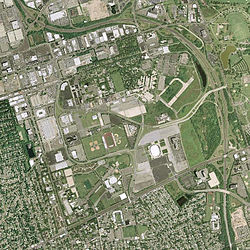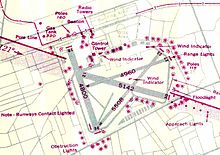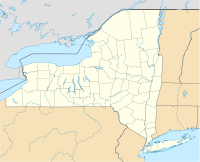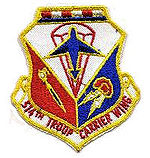- Mitchel Air Force Base
-
Mitchel Air Force Base 
Former Mitchel AFB, 2006. The remains of runway 5/23 are visible in the center. 
Airport Diagram (pre-runway 5/23 extension) IATA: none – ICAO: none Summary Airport type Military/Defunct Owner United States Air Force Operator United States Air Force Serves New York City Location Garden City, New York Elevation AMSL 85 ft / 26 m Coordinates 40°43′32″N 73°35′42″W / 40.72556°N 73.595°WCoordinates: 40°43′32″N 73°35′42″W / 40.72556°N 73.595°W Runways Direction Length Surface ft m 5/23 6,700 1,737 Concrete 9/27 4,960 1,512 Concrete 12/30 5,142 1,567 Concrete 18/36 4,800 1,463 Concrete Source: Airfields-Freeman.com [1] - For the airport in Wisconsin see General Mitchell International Airport
- For the airport in South Dakota see Mitchell Municipal Airport
Mitchel Air Force Base also known as Mitchel Field, was a United States Air Force base located on the Hempstead Plains of Long Island, New York, US Established in 1918 as Hazelhurst Aviation Field #2, the facility was renamed Mitchel Field in honor of former New York City Mayor John Purroy Mitchel who was killed while training for the Air Service in Louisiana.
Decommissioned in 1961, Mitchel Field became a multi-use complex currently home to the Cradle of Aviation Museum, Nassau Coliseum, Mitchel Athletic Complex, Nassau Community College and Hofstra University.
Contents
History
Origins
For almost 250 years the area occupied by Mitchel AFB has played an important role in United States history.
During the American Revolutionary War it was known as the Hempstead Plains and used as an Army enlistment center. In the War of 1812 and in the Mexican War it was a training center for Infantry units. During the American Civil War, it was the location of Camp Winfield Scott. In 1898, in the Spanish-American War, Mitchel's site was known as Camp Black.[2]
World War I
During World War I Camp Mills was located at the site of Mitchel AFB, on the western part, with the United States Army Rainbow (42nd) Division and the Fighting 69th Regiment training there.[2]
In 1917, Hazelhurst Field #2 was established just south of Hazelhurst Field to serve as an additional training and storage base. Curtiss JN-4 Jennies became a common sight over Long Island in 1917 and 1918. Hundreds of aviators were trained for war at these training fields, two of the largest in the United States. Numerous new wooden buildings and tents were erected on Roosevelt and Field #2 in 1918 in order to meet this rapid expansion.[3]
Between the Wars
Mitchel Field continued to grow after World War I and between 1929 and 1932. An extensive building program was undertaken after the war to turn the temporary wartime facilities into a permanent Army post, with new barracks, warehouses, hangar space and administrative buildings. Much of this construction still exists today, being used for non-military purposes.
In the 1920s and 1930s various Observation, Fighter and Bomber units were stationed at the airfield. It became a major aerodrome for both the Air Corps as well as various civilian activity. The 1920s was considered the golden age of Air Racing and on 27 November 1920, the Pulitzer Trophy Race was held at Mitchel Field. The race consisted of four laps of a 29-mile course. Thirty-eight pilots entered and took off individually. The winner was Capt. Corliss Moseley, flying a Verville-Packard VCP-R racer, a cleaned-up version of the Army’s VCP-1 pursuit, at 156.54 mph.[4]
In October 1923, Mitchel Field was the scene of the first airplane jumping contest in the nation. During the same year, two world's airplane speed records were established there. In 1924, the air mail service had its inception in experimental flights begun at the airfield. In September 1929, Lt. Gen. James H. Doolittle, then a Lieutenant, made the world's first blind flight.[5]
In 1938, Mitchel was the starting point for the first nonstop transcontinental bomber flight, made by Army B-18 Bolos. Mitchel Field also served as a base from which the first demonstration of long-range aerial reconnaissance was made. In May 1939, three B-17s led by Lt. Curtis LeMay flew 750 miles out to sea and intercepted the Italian ocean liner SS Rex. This was a striking example of the range, mobility and accuracy of modern aviation at the time.[6][7]
World War II
In 1940 Mitchel Field was the location of the Air Defense Command, a command charged with the mission of developing the air defense for cities, vital industrial areas, continental bases, and military facilities in the United States (also known as the "Zone of the Interior"). Later, First Air Force, was given the responsibility for air defense planning and organization along the eastern seaboard Under its supervision an aircraft patrol system along the coast for observing shipping was placed into operation.[2] During 1943, Mitchel AAF became a staging area for B-24 Liberator and crews before being sent overseas.[8]
Mitchel Field was a major source of supply in initial garrisoning and defense of North Atlantic air bases in Newfoundland, Greenland and Iceland. From the airfield the planning for the air defense of Nova Scotia and Newfoundland was conducted. Antisubmarine patrol missions along the Atlantic coast were carried out in 1942 by the Army Air Force Antisubmarine Command aircraft based at Mitchel.[2]
Under the direction of the First Air Force, Mitchel Army Airfield became a command and control base for both I Fighter and I Bomber Command. Tactical fighter groups and squadrons were formed at Mitchel to be trained at AAF Training Command bases (mostly in the east and southeast) before being deployed to the various overseas wartime theaters. Additionally, thousands of Army Air Force personnel were processed through the base for overseas combat duty. With the end of World War II, returning GIs were processed for separation at Mitchel.[2]
United States Air Force
In March 1946 Mitchel Army Airfield was designated as the location for the headquarters of the newly formed Air Defense Command (ADC), which was responsible for the air defense of the United States. With the establishment of the United States Air Force as a separate service in 1947, Mitchel AAF was redesignated as Mitchel AFB.
In December 1948, ADC's responsibilities were temporarily assumed by the Continental Air Command, (ConAC) also located at Mitchel AFB. ConAC also was responsible for the reorganization of the Air Force Reserve after World War II. In 1949, the reserve mission was assigned to First Air Force, which was also headquartered at Mitchel. First Air Force became the command and control organization for supervising the training of the air reserve in 15 eastern states and the District of Columbia.[2]
By 1949, Mitchel was relieved of the responsibility for defending New York City because of the many problems associated with operating tactical aircraft in the urban area. However, Mitchel did serve as the terminus for the last speed record set on Long Island, a transcontinental speed record of 4 hours, 8 minutes set by Colonel W. Millikan in an F-86 on 2 January 1954. After several notable crashes, including a P-47 into Hofstra University's Barnard Hall on 23 March 1943,[9] public pressure ultimately led to the field's closure.[3]
Beginning in 1949, the Air Force Reserve's 514th Troop Carrier Wing was the main operational flying organization at Mitchel AFB. Initially flying the Curtiss C-46 Commando, the unit upgraded to the Fairchild C-119 Flying Boxcar in 1954. However the urban creep around Mitchel led to the decision to curtail flying at the base, and in April 1961 flying was halted and the unit reassigned to McGuire AFB in New Jersey. With the reassignment of the 514th, Mitchel itself was subsequently closed on on 25 June 1961. The property was turned over to Nassau County for redevelopment.[3][10][11]
Although closed as an Air Force base, the facility today still has military housing, a commissary and exchange facilities to support military families and activities in the area. The Garden City-Mitchel Field Secondary, a remnant of the Long Island Rail Road's Central Branch from Garden City to Bethpage, ends in the northern part of Mitchel Field, providing sporadic freight service.
Major commands to which assigned
- Aviation Section, U.S. Signal Corps, July 1917
- Division of Military Aeronautics, 29 May 1918
- Redesignated: Director of Air Service
- Redesignated: U.S. Army Air Service, 24 May 1918
- Redesignated: U.S. Army Air Corps, 2 July 1926
- General Headquarters (GHQ) Air Force, 1 March 1935
- Northeast Air District, 18 October 1940
- Redesignated: 1st Air Force, 26 March 1941
- Redesignated: First Air Force, 18 September 1942
- Continental Air Forces, 13 December 1944
- Air Defense Command, 21 March 1946
- Continental Air Command, 1 December 1948 – 1 April 1961
- Remained attached to Air Defense Command until 1 January 1951
Major units assigned
- 92d Aero Squadron, 4 December–21, 1918
- 1st Army Observation Group
- 1st Aero Squadron, 10 October 1919 – 6 November 1940
- Reassigned to 9 Group (Observation), 1 August 1922
- 3d Observation Group
- 5th Aero Squadron, 1 November 1919 – 6 November 1940
- Reassigned to 9 Group (Observation), 1 August 1922
- (32 other Aero Squadrons, Unknown organizations, 1919)[12]
- 9 Group (Observation), 1 August 1922
- Redesignated: 9 Observation Group on 25 January 1923
- Redesignated: 9 Bombardment Group on 1 March 1935
- Redesignated: 9 Bombardment Group (Medium) on 6 December 1939 – 6 November 1940
- 99th Observation Squadron, 9 November 1928 – 6 November 1940
- 9th Air Division, 1 April 1931 – January 1933
- 22d Bombardment Group, 1 February – 14 November 1940
- 8th Fighter Group, 5 November 1940 – 26 January 1942
- 57th Fighter Group, 15 January 1941 – 19 August 1941
- Headquarters, Northeast Air District, 18 October 1940
-
- Redesignated: 1st Air Force, 26 March 1941
- Redesignated: First Air Force, 18 September 1942 – 3 June 1946; 17 October 1949 – 23 June 1958
- Headquarters, I Air Support Command, 1 September 1941
- Redesignated: I Ground Air Support Command, 1 April 1942
- Redesignated: I Air Support Command, 1 September – 30 November 1942
- Headquarters, I Bomber Command, 1 October 1943 – 21 March 1946
- Headquarters, I Interceptor Command, 5 June – 27 December 1941
- Redesignated: I Fighter Command, 9 June 1942 – 21 March 1946
- 326th Fighter Group, 19 August 1942 – 1 September 1942
- 352d Fighter Group, 1 October–31, 1942
- 353d Fighter Group, 1 October–7, 1942
- 62d Fighter Wing, 12 December 1942 – 13 January 1943
- 80th Fighter Group, 2 March – 30 April 1943
- 356th Fighter Group, 30 May – 4 July 1943
- 36th Fighter Group, 3 June–23, 1943
397th Fighter Squadron (368th Fighter Group, 23 August 1943-20 December 1943
-
- 362d Fighter Group, 19 October – 12 November 1943
- 301st Fighter Wing, 1 November 1944 – 30 May 1945
- 373d Fighter Group, 28 September – 7 November 1945
- Headquarters, Air Defense Command, 21 March 1946 – 1 January 1951
- 355th Fighter Group (Air Defense) (ADC), 1 August – 20 November 1946
- 4th Fighter Wing (AFRES), 20 December 1946 – 27 June 1949
- 319th Bombardment Group (AFRES), 27 December 1946 – 27 June 1949
- 325th Fighter Group (ADC), 3 August–31, 1942; 21 May – 2 December 1947
- 318th Fighter Squadron, 21 May – 2 December 1947
- 78th Fighter Group (ADC), 1 June 1947 – 1 November 1948
- 82d Fighter Squadron, 25 June 1947 – 24 November 1948
- 83d Fighter Squadron, 25 June 1947 – 24 November 1948
- 84th Fighter Squadron, 25 June 1947 – 24 November 1948
- 320th Bombardment Group (AFRES), 9 June 1947 – 27 June 1949
- 52d Fighter-Interceptor Wing (ADC), 9 June 1948 – 4 October 1949
- 2nd Fighter-Interceptor Squadron, 25 June 1947 – 4 October 1949
- 5th Fighter-Interceptor Squadron, 25 June 1947 – 4 October 1949
- 1112th Special Air Missions Squadron (MATS), 19 July 1948 – 15 March 1951
- 2500th Air Base Group (later Wing), 28 September 1948 – 25 June 1961
- Headquarters, Continental Air Command, 1 December 1948 – 1 April 1961
- 84th Fighter Wing, (All Weather) (ADC), 1 June – 10 October 1949
- Headquarters, Eastern Air Defense Force (ADC), 1 September 1949 – 1 August 1950
- 514th Troop Carrier Wing (AFRES), 10 October 1949 – 1 February 1953; 1 April 1953 – 15 March 1961
- 65th Troop Carrier Wing (AFRES), 14 June 1952 – 1 April 1953
- 313th Troop Carrier Wing (18th Air Force), 1 February – 25 August 1953.
- Replaced by: 465th Troop Carrier Wing (18th Air Force), 25 August 1953 – 23 March 1954
Notes: Records incomplete for units assigned prior to 1940; Air Defense Command (ADC); Air Force Reserve (AFRES) assigned to Continental Air Command (ConAc); 18th Air Force Troop Carrier Wings assigned to Tactical Air Command; Military Air Transport Service (MATS) 1112th Special Air Missions Squadron (SAMS) provided VIP transportation in New York area for Commanding General, First Army, General Eisenhower and UN Military Staff using VC-47. The SAM mission was taken over by the 1254th Air Transport Group at Bolling AFB with deployed aircraft (1298th ATS, 1299th ATS) to Mitchel.
Source for Major Commands and Major Units assigned:[10][12][13][14][15][16][17]
See also
- Roosevelt Field
- Mitchel Field Bus Depot
- New York World War II Army Airfields
References
 This article incorporates public domain material from websites or documents of the Air Force Historical Research Agency.
This article incorporates public domain material from websites or documents of the Air Force Historical Research Agency.- ^ Abandoned & Little-Known Airfields: New York, Central Long Island
- ^ a b c d e f Office of Information Services Headquarters Continental Air Command, Mitchel Air Force Base, New York, 26 October 1955 Fact Sheet
- ^ a b c The History of Mitchel Field, The Cradle of Aviation Museum
- ^ Pulitzer Trophy Air Races
- ^ USAFHRA Document 00489043
- ^ Mitchel Field History Document
- ^ John T. Correll, Rendezvous With the Rex, Air Force Magazine, December 2008 Vol 91 No. 12
- ^ USAFHRA Document 00175652
- ^ Associated Press, "College Building Set Afire by Crash of Army Airplane", The Roanoke World-News, Roanoke, Virginia, Tuesday afternoon, 23 March 1943, Volume 81, Number 70, page 3.
- ^ a b USAFHRA Document 00489094
- ^ USAFHRA Organizational Records Branch, 514th Air Mobility Wing
- ^ a b Mauer, Mauer (1969), Combat Squadrons of the Air Force, World War II, Air Force Historical Studies Office, Maxwell AFB, Alabama. ISBN 0-89201-097-5
- ^ Air Force Historical Research Agency Organizational Records Branch
- ^ Ravenstein, Charles A. (1984). Air Force Combat Wings Lineage and Honors Histories 1947–1977. Maxwell AFB, Alabama: Office of Air Force History. ISBN 0-912799-12-9.
- ^ Maurer, Maurer (1983). Air Force Combat Units Of World War II. Maxwell AFB, Alabama: Office of Air Force History. ISBN 0-89201-092-4.
- ^ USAFHRA Document 00175687 (2500 ABG/Wing)
- ^ 11 October 1950: 100,000 miles to Bolling
18. Grace, Dr. Timothy M. (2008) SECOND TO NONE: THE HISTORY OF THE 368TH FIGHTER GROUP
External links
- Cradle of Aviation Museum
- Hempstead Plains-Mitchel Field
- Hempstead Plains-Mitchel Field Remembrances
- Hempstead Plains-Early Photos
- Mitchel Field Memories
- Mitchel Field in Wartime Newsday article
- US Family Health Plan
Bases CONUSAdair · Beale · Bong (unbuilt) · Charleston · Davis-Monthan · Dobbins · Dover · Dow · Duluth · England · Ent · Ethan Allen · Fairfax · Fort Lee · Geiger · George · Glasgow · Grand Forks · Grenier · Griffiss · Gunter · Hamilton · Hancock · Homestead · Hurlburt · Imeson · K.I. Sawyer · Kincheloe · Kingsley · Kirtland · Larson · Luke · March · Malmstrom · McCoy · McChord · McClellan · McGhee Tyson · McGuire · Minneapolis-St. Paul · Minot · Mitchel · New Castle · Niagara Falls · Norton · O'Hare · Oklahoma City · Otis · Oxnard · Paine · Perrin · Peterson · Pittsburgh · Pope · Portland · Presque Isle · Richards-Gebaur · Selfridge · Seymour Johnson · Sioux City · Snelling · Stead · Stewart · Suffolk County · Tinker · Travis · Truax · Tyndall · Vandenburg · Webb · Westover · Willow Run · Wright-Patterson · Wurtsmith · Youngstown
OverseasErnest Harmon · Frobisher Bay · Goose Bay · Keflavik · Pepperrell · Thule · Topsham

Stations CONUSAlmaden · Charleston · Clear · Cross City · Benton · Empire · Mill Valley · Montauk · Mount Hebo · North Truro · Point Arena · Rye · Thomasville · Watertown
OverseasAlbrook
Air
Defense
unitsForcesAir
DivisionsSectorsAlbuquerque · Bangor · Boston · Chicago · Detroit · Duluth · Goose · Grand Forks · Great Falls · Iceland · Kansas City · Los Angeles · Minot · Montgomery · New York · Oklahoma City · Phoenix · Portland · Reno · Sault Sainte Marie · San Francisco · Seattle · Sioux City · Spokane · Stewart · Syracuse · Washington
WingsGroups1st · 4th · 10th · 14th · 15th · 23rd · 32nd · 33rd · 50th · 52nd · 53rd · 54th · 56th · 57th · 73rd · 78th · 79th · 81st · 82nd · 84th · 325th · 326th · 327th · 328th · 329th · 337th · 355th · 408th · 412th · 414th · 473rd · 475th · 476th · 478th · 500th · 501st · 502d · 503d · 507th · 514th · 515th · 516th · 517th · 518th · 519th · 520th · 521st · 525th · 527th · 528th · 529th · 530th · 533d · 534th · 564th · 566th · 567th · 568th · 575th · 678th · 701st · 4676th · 4700th · 4721st · 4722d · 4727th · 4728th · 4729th · 4730th · 4731st · 4732d · 4733d · 4734th · 4735th · 4756th
SquadronsAerospace Defense Command Fighter Squadrons · Aircraft Control and Warning Squadrons
Major
weapon
systemsElectronicFightersMissiles1 · 2 · 3 · 4 · 5
ShipsGuardian · Interceptor · Interdictor · Interpreter · Investigator · Locator · Lookout · Outpost · Pickett · Protector · Scanner · Searcher · Skywatcher · Tracer · Watchman · Vigil
Miscellaneous Command Wings 25th Antisubmarine · 26th Antisubmarine
Groups 1st Search Attack · 2d Bombardment · 13th Bombardment · 45th Bombardment · 304th Bombardment · 377th Bombardment · 378th Bombardment · 479th Antisubmarine · 480th Antisubmarine
Squadrons AntisubmarineOther2d Search Attack · 3d Search Attack · 4th Search Attack
Airfields United StatesDover (Delaware) · Drew (Florida) · Jacksonville (Florida) · Key West (Florida) · Lantana (Florida) · Miami (Florida) · Orlando (Florida) · Savannah (Georgia) · Grenier (New Hampshire) · Atlantic City (New Jersey) · Fort Dix (New Jersey) · Mitchel (New York) · Bluethenthal (North Carolina) · Cherry Point (North Carolina) · Charleston (South Carolina) · Hyannis (Massachusetts) · Otis (Massachusetts) · Westover (Massachusetts) · Langley (Virginia)
NewfoundlandCaribbeanEuropeNorth Africa USAAF First Air Force in World War II
USAAF First Air Force in World War IIAirfields · First Air Force Replacement Training Stations · First Air Force Tactical Airfields
Units Commands I Bomber Command (1941-42) · I Bomber Command (1943-1946) · I Fighter Command · I Ground Air Support Command · I Troop Carrier CommandWings 25th Antisubmarine · 50th Troop Carrier · 52d Troop Carrier · 53d Troop Carrier · 60th Troop Carrier · 61st Troop Carrier · Boston Fighter · New York Fighter · Norfolk Fighter · Philadelphia FighterGroups Bombardment 2d Bombardment · 13th Bombardment · 22d Bombardment · 34th Bombardment · 43d Bombardment · 45th Bombardment · 301st Bombardment · 302d Bombardment · 400th Bombardment · 402d Bombardment · 455th Bombardment · 459th Bombardment · 460th Bombardment · 471st BombardmentCombat Cargo Fighter 8th Fighter · 31st Fighter · 33d Fighter · 52d Fighter · 56th Fighter · 57th Fighter · 58th Fighter · 59th Fighter · 79th Fighter · 80th Fighter · 83d Fighter · 87th Fighter · 324th Fighter · 325th Fighter · 326th Fighter · 327th Fighter · 332d Fighter · 348th Fighter · 352d Fighter · 353d Fighter · 355th Fighter · 356th Fighter · 358th Fighter · 359th Fighter · 361st Fighter · 362d Fighter · 365th Fighter · 366th Fighter · 368th Fighter · 370th Fighter · 371st Fighter · 373d Fighter · 402d Fighter · 413th Fighter · 476th FighterReconnaissance 26th Reconnaissance · 73d ReconnaissanceTroop Carrier 10th Troop Carrier · 60th Troop Carrier · 61st Troop Carrier · 62d Troop Carrier · 63d Troop Carrier · 89th Troop Carrier · 313th Troop Carrier · 314th Troop Carrier · 315th Troop Carrier · 316th Troop Carrier · 317th Troop Carrier · 349th Troop Carrier · 375th Troop Carrier · 403d Troop Carrier · 433d Troop Carrier · 434th Troop Carrier · 435th Troop Carrier · 436th Troop Carrier · 437th Troop Carrier · 438th Troop Carrier · 439th Troop Carrier · 440th Troop Carrier · 441st Troop Carrier · 442d Troop CarrierOther Categories:- USAAF First Air Force Group Training Stations
- 1918 establishments in the United States
- Airfields of the United States Army Air Service
- General Headquarters Air Force Airfield
- Airfields of the United States Army Air Corps
- USAAF First Air Force Replacement Training Stations
- USAAF First Air Force Tactical Airfields
- Initial United States Air Force installations
- Closed facilities of the United States Air Force
- Garden City, New York
- Sports venues in Long Island
- Airports on Long Island
- Defunct airports in New York
Wikimedia Foundation. 2010.






